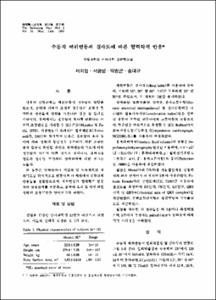수동적 체위변동과 경사도에 따른 혈력학적 반응
- Alternative Author(s)
- Chae, E Up; Song, Dae Kyu; Suh, Young Sung; Park, Won Kyun
- Journal Title
- Keimyung Medical Journal
- Issued Date
- 1992
- Abstract
- The purpose of this study was to investigate the relationship between the effects of gravity and regulatory mechanisms of the cardiovascular system by obwerving hemodynamic responses to passive body tilts.
The study was carried out in 12 healthy young adult males. The postural changes were passively tilted from the supine control position(SCP) to the 15˚, 30˚ and 60˚ head-up position(HU), and then the 30˚ and 15˚ head-down position(HD) using a tilting table, and lasted for 5 minutes in each grade of the tilted position.
Cardiac output(Q), stroke volume(SV), acceleration index(ACI) of the heart, and thoracic electrical bioimpedance were measured by the impedance cardiograph. Thoracic fluid volume(TFV) changes were calculated by the principle of impedance plethysmography. In addition, blood pressure(BP), heart rate(HR), total systemic vascular resistance(R), and ECG were measured.
In the postural changes from supine to the 15˚, 30˚ and 60˚ HU, the SV gradually decresaed(p<0.01) by 11%, 26% and 42%, and the Q also decreased by 10%(p<0.05), 19% and 24%(p<0.01) respectively as compared with SCP. However, The HR and R gradually increased.
On the contrary, in the postural changes from supine to the 30˚ and 15˚ HD, the SV increased by 16% and 14%, and the Q increased by 12% and 11% respectively and the HR and R decreased.
The ACI increased in the HD, but decreased in the HU with the increasing fraction of the tilting degree.
There was no significant change in the systolic BP, and the mean BP and diastolic BP gradually increased proportionally to the tilting degree in the HU, but they decreased in the HD.
The TFV gradually increased in the HD, and it decreased in the HU.
The average electrical axis of QRS complex on ECG was 56.1˚ in the SCP and it increased in the HU, however it decreased in the HD.
In general, it is speculated that changes of hemodynamic variables on the effect of gravity were positively related to the tilting degree.
From the above results, it may be suggested that the cardiopulmonary baroreceptors reduce R and HR to maintain BP against the increase of central blood volume. It may be also suggested that, as the tilting degree increases in the HU, both the arterial baroreceptors and cardiopulmonary baroreceptors are involved in the regulatory mechanisms. It can ve said that changes of the SV of the heart are related to Frank-Staring's law according to the venous return.
In spite of the possibility of the fact that the atrial baroreceptors may increase the HR by the Bainbridge reflex in consequence of atrial distention in the HD, however, the negative chronotropic effect through cardiopulmonary baroreceptors appeared to be predominant.
This study provides enidence that the extent of the cardiovascular regulation is proportional to the effects of gravity that is demonstrated by the magnitude of hydrostatic pressure according to the tilting degree.
- Alternative Title
- Hemodynamic Responses to Head-up and Head-down Tilts
- Department
- Dept. of Physiology (생리학)
Dept. of Family Medicine (가정의학)
Dept. of Medical Education (의학교육학)
- Publisher
- Keimyung University School of Medicine
- Citation
- 채의업 et al. (1992). 수동적 체위변동과 경사도에 따른 혈력학적 반응. Keimyung Medical Journal, 11(2), 195–204.
- Type
- Article
- 파일 목록
-
-
Download
 11-195.pdf
기타 데이터 / 582.41 kB / Adobe PDF
11-195.pdf
기타 데이터 / 582.41 kB / Adobe PDF
-
Items in Repository are protected by copyright, with all rights reserved, unless otherwise indicated.